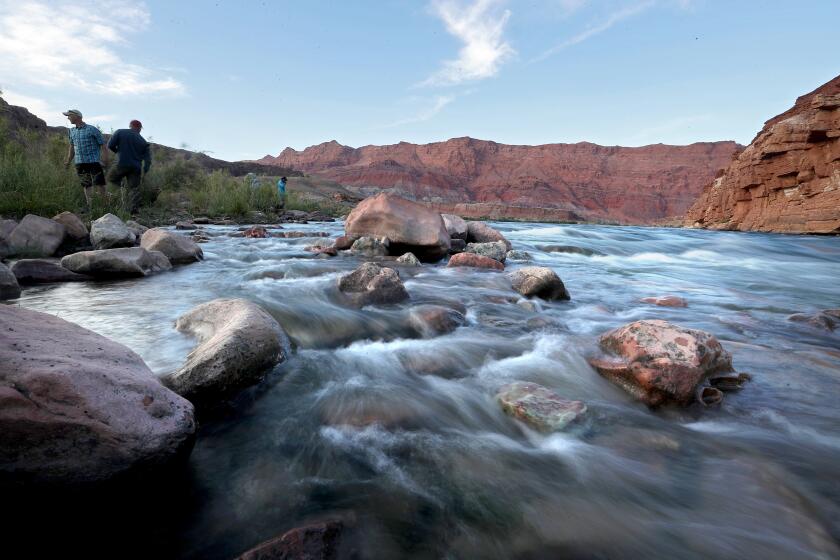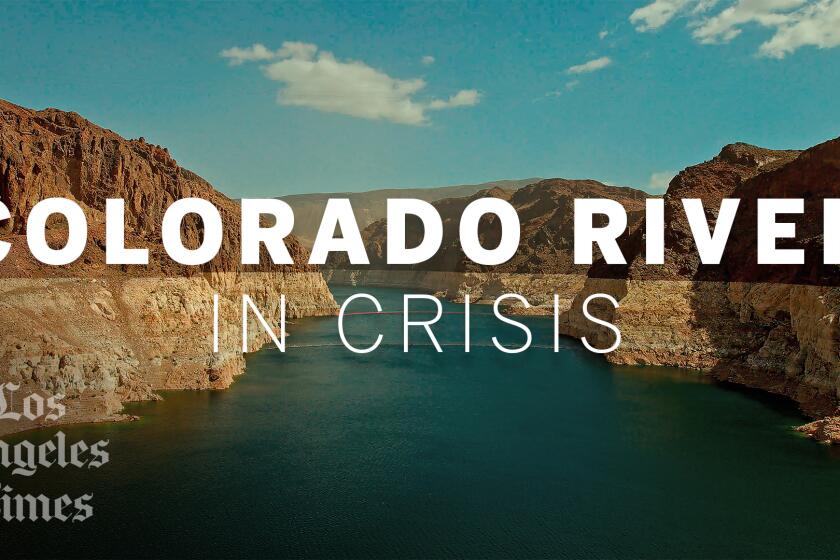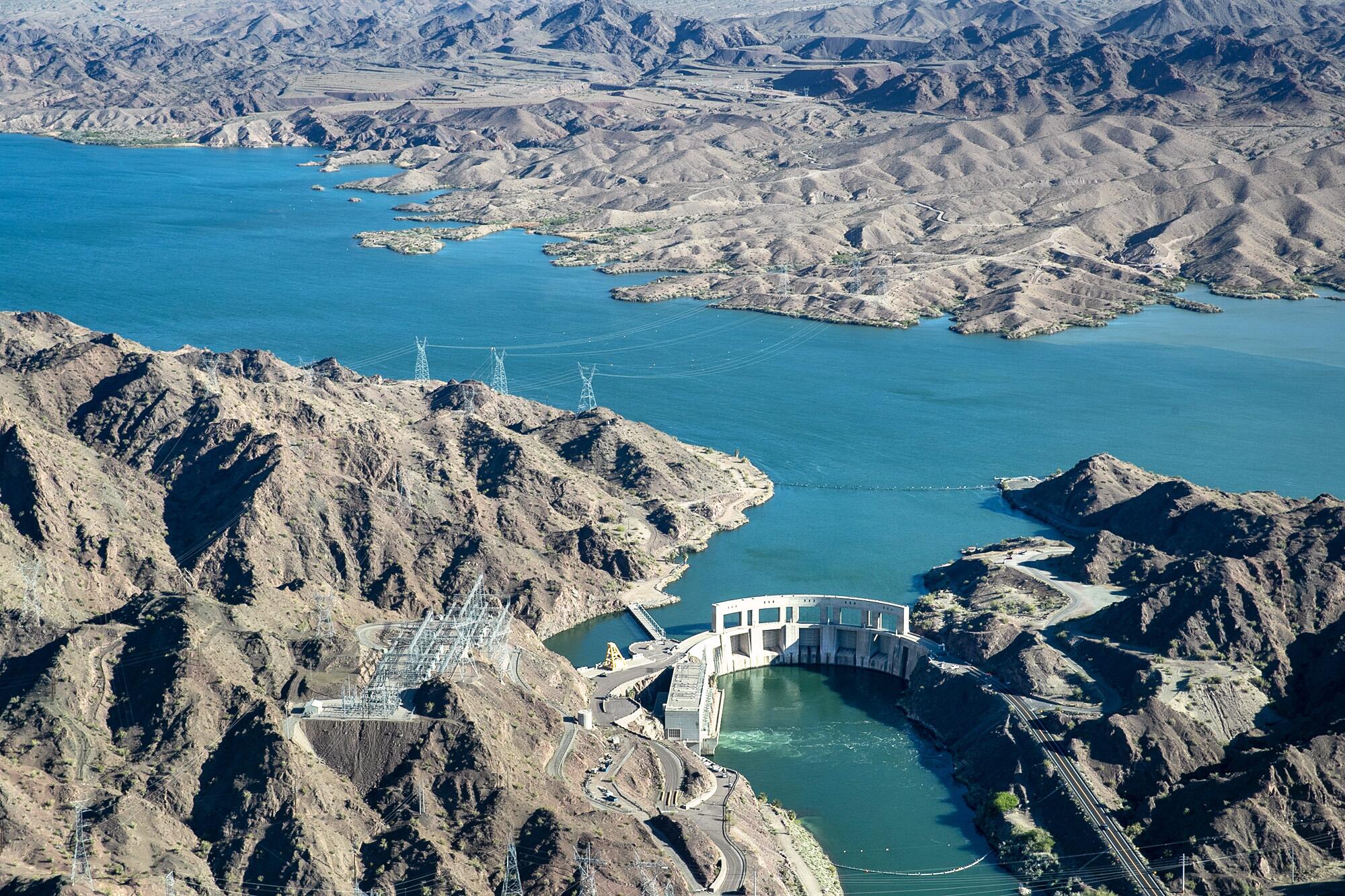
- Share via
The Biden administration has announced new water-saving agreements with California water agencies intended to shore up supplies on the overburdened Colorado River.
California’s Colorado River Board said Wednesday that several water agencies and one tribal nation signed the first in a series of agreements that will conserve up to 1.6 million acre-feet of water.
The agreements build on previous commitments by California, Arizona and Nevada to reduce water use by 3 million acre-feet over three years, cutting usage by about 14% across the Southwest. Much of the reductions are occurring in exchange for payments funded through the Inflation Reduction Act.
Aggressive and impactful reporting on climate change, the environment, health and science.
The deals to reduce water use are aimed at boosting the levels of Lake Mead, the nation’s largest reservoir near Las Vegas, which now stands at 34% of capacity.
The latest agreements “represent another critical step in our collective efforts to address the water management challenges the Colorado River Basin faces due to drought and climate change,” said federal Reclamation Commissioner Camille Calimlim Touton. “Addressing the drought crisis requires an all-hands-on-deck approach, and close collaboration.”
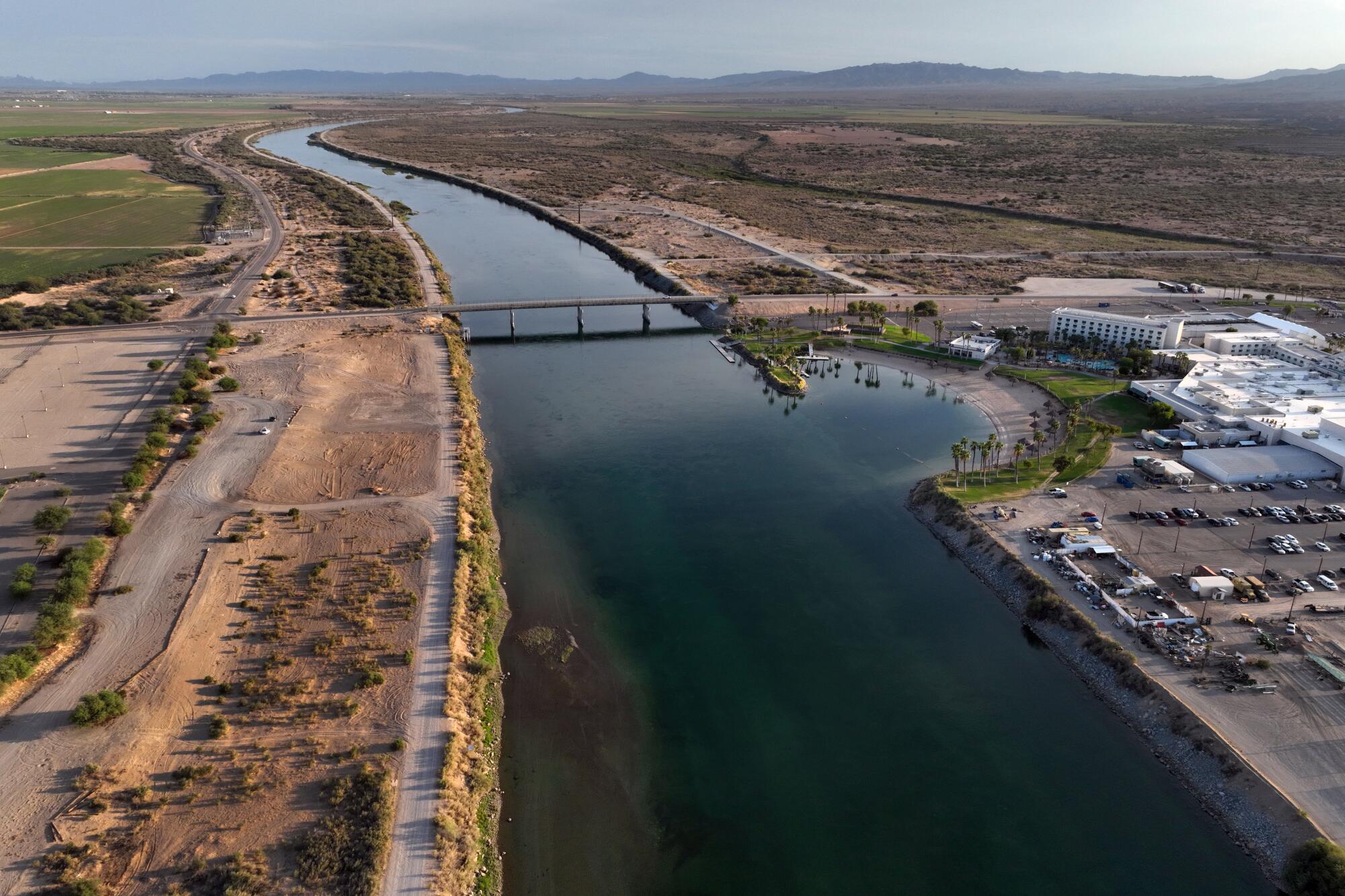
The Colorado River provides water for cities, farms and tribal nations across seven states from Wyoming to Southern California, as well northern Mexico.
For decades, the river has been so heavily used that it seldom reaches the sea, and much of its delta in Mexico has been reduced to a dry riverbed, with only small remnants of its once-vast wetlands surviving.
The federal government is opening negotiations on long-term plans for the Colorado River. Leaders of tribes say they don’t want to be left out of key talks.
The river’s flow has declined dramatically since 2000, and research has shown that global warming driven by the burning of fossil fuels has worsened the long stretch of extremely dry years.
Scientists have found that roughly half the decline in the river’s flow this century has been caused by rising temperatures, and that for each additional 1.8 degrees of warming, the river’s average flow is likely to decrease about 9%.
The water-saving efforts pledged by the states are the latest in a series of incremental steps intended to help the region adapt.
Interior Department officials said the newly signed agreements secure conservation pledges of up to 643,000 acre-feet of water through 2025. The agreements, which were announced in Las Vegas, include $295 million in federal funds for conservation, water efficiency and protection of environmental resources. An acre-foot of water is enough to supply about three average homes for a year.
The Coachella Valley Water District has agreed to save up to 105,000 acre-feet of water through 2025, roughly 10% of its supply from the river. The district’s proposal was approved earlier this year, and involves curtailing the use of Colorado River water for replenishing groundwater. In exchange, the federal government is paying $400 per acre-foot of water.

In another agreement, the Quechan Tribe of the Fort Yuma Indian Reservation agreed to save up to 39,000 acre-feet of water in the next two years.
“The Colorado River is the lifeblood of the Quechan people, and we are committed to doing everything possible to ensure it remains a living river,” Quechan Tribe President Jordan Joaquin said in a written statement. He said the agreement reflects strong partnerships with state and federal water agencies, and is an important step in ensuring the river can continue to sustain the tribe, other water users and the ecosystem.
Leaders of California’s Imperial Irrigation District, which delivers the single largest share of Colorado River water to farmland in the Imperial Valley, this month approved another agreement to conserve up to 100,000 acre-feet of water.
That deal secured reductions in water use through an existing agricultural conservation program in the Imperial Valley and negotiations among several agencies. About half of the water had previously been earmarked to be sent to the San Diego County Water Authority under a water transfer agreement, but will instead remain in Lake Mead. The conserved water is enough to raise the reservoir’s level 1.5 feet.
Years ago, scientists said climate change would bring a Colorado River crisis. Their warnings, which largely went unheeded, are now playing out.
California water officials said additional agreements are expected to be signed in 2024 with other agencies, including the Imperial Irrigation District, Coachella Valley Water District and Bard Water District. Details of some agreements are still being negotiated.
“Less than a year ago, we faced the worst possible consequences of drought and interstate conflict. Today, California’s agricultural, urban, and tribal users are banding together through these agreements to protect the Colorado River,” said JB Hamby, chair of California’s Colorado River Board. He called the progress “an incredible turnaround.”
Adel Hagekhalil, general manager of the Metropolitan Water District of Southern California, said each of the agreements provides vital water to help raise reservoir levels.
“This collaborative effort, including federal financial support and Metropolitan’s commitment to leave more than 400,000 acre-feet of water in Lake Mead this year, will help stabilize the reservoir while we negotiate longer-term solutions,” Hagekhalil said.
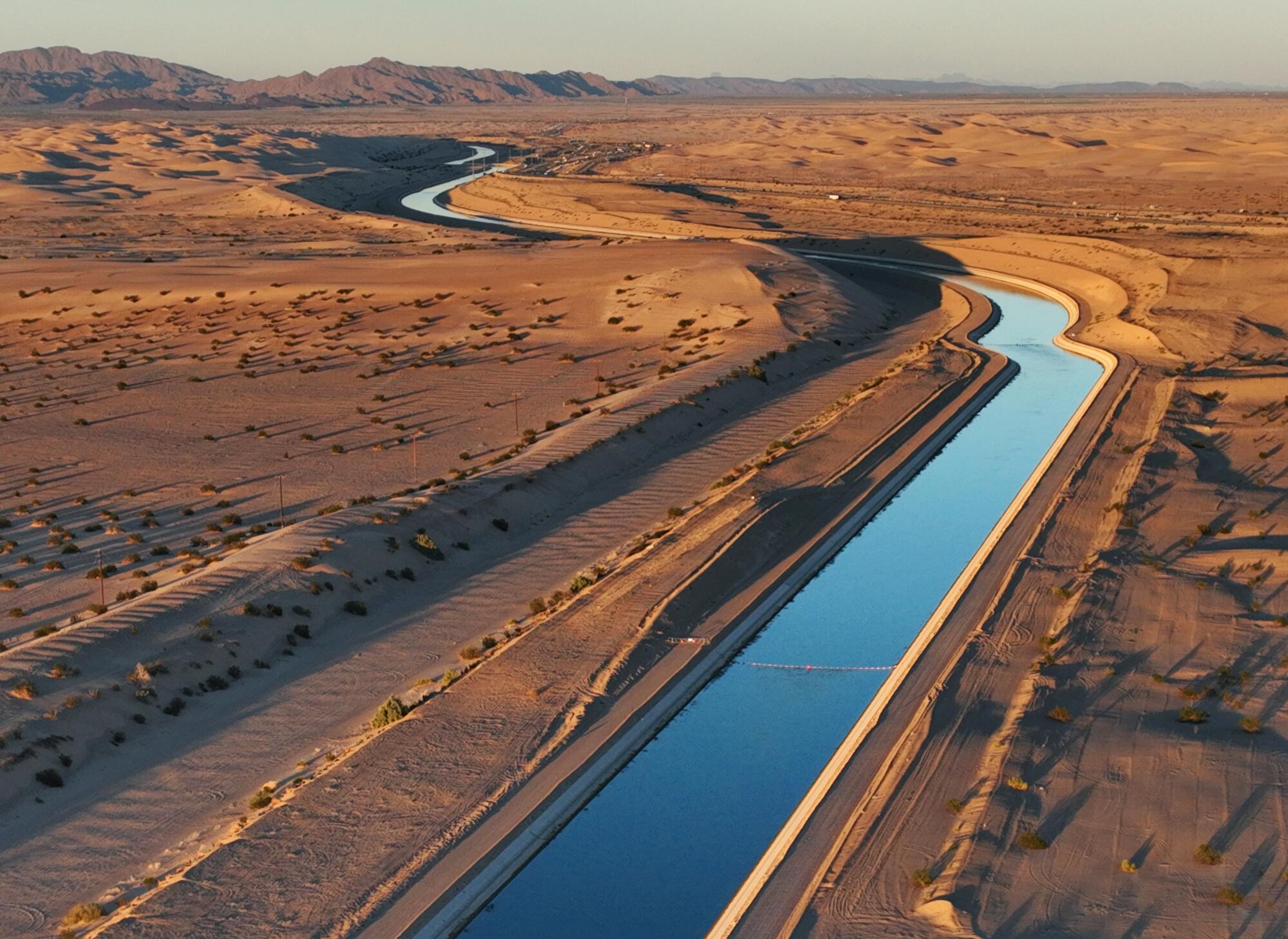
In October, the federal government released an analysis showing that current plans for reducing water use along the Colorado River should be sufficient to stave off risks of reservoirs reaching critically low levels over the next three years. The U.S. Bureau of Reclamation cited 2023’s above-average snowpack in the Rocky Mountains as a key factor that has helped reduce the risk of a crash in supplies between now and the end of 2026, when the current rules for dealing with shortages expire.
Federal officials said those voluntary conservation efforts help put the region on course to focus on discussing new long-term rules for managing the river over the next two decades.
In a related step, the Biden administration announced this month that $72 million is now available to support environmental projects at the shrinking Salton Sea, contributing to state efforts to control dust and build artificial wetlands along the retreating shores.
Democratic Sen. Alex Padilla praised the federal support for water conservation and environment projects to help protect public health and the ecosystem at the Salton Sea, which has shrunk as the amount of water feeding the lake has decreased over the years.
“In the face of historic drought and the climate crisis, California water agencies have led the way in developing creative solutions to protect our water supply,” Padilla said. “I am glad to see this Inflation Reduction Act funding flow to California water users who voluntarily stepped up to conserve water and keep the system afloat.”
Padilla said he worked to ensure that the Inflation Reduction Act included $4 billion for drought resilience and inland waterways, including the Colorado River and the Salton Sea. He said the latest agreements “will allow us to turn toward the hard work of crafting post-2026 guidelines and building long-term resiliency.”
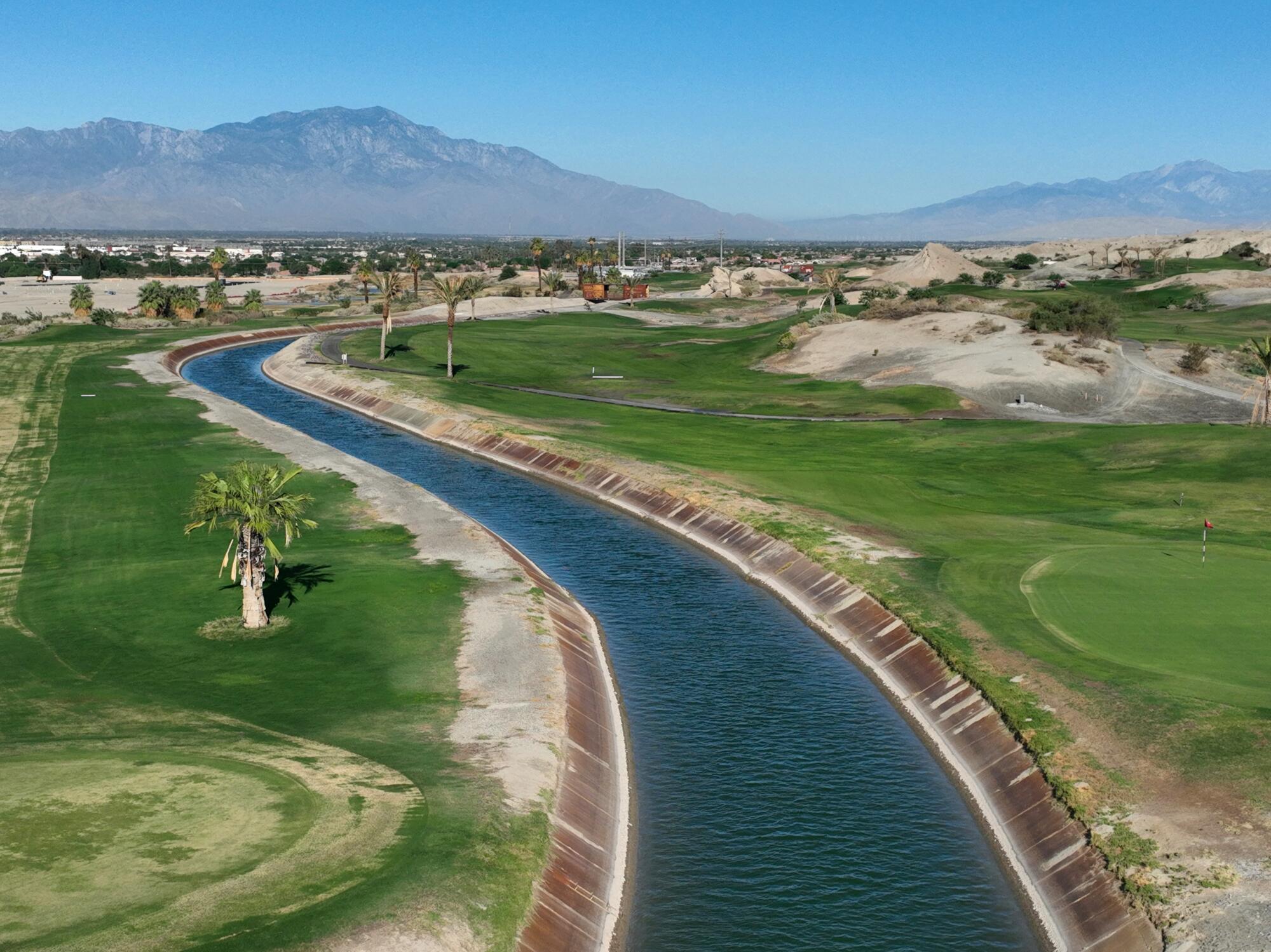
Bill Hasencamp, the MWD’s manager of Colorado River resources, said the agreements “seem to be working better than planned,” and California’s water districts are exceeding their conservation targets, indicating they should have no problem achieving the reductions they have pledged over the next three years.
“California’s water use is at its lowest level since the 1940s, historically low,” Hasencamp said. “Everyone is stepping up — ag, urban, tribes all are significantly reducing their water use this year. And other states too.”
Scientists have said the region will need to come up with larger reductions in water use to address the river’s chronic water-supply deficit and the effects of climate change.
Touton, the Bureau of Reclamation’s commissioner, praised the efforts by California’s water managers.
“California has certainly stepped up to protect the river systems and the communities that rely on it,” Touton said in a speech. “And we’re already seeing the results of these efforts.”
She said conservation efforts, combined with the snowpack in 2023, allowed the region to conserve more water in Lake Mead than any other time over the past 30 years.
Touton noted that Lake Powell, the river’s second-largest reservoir, has risen 44 feet and is now 37% full, while Lake Mead is 40 feet higher than it was projected to be at this time a year ago.
Still, Touton said, it’s vital for the region to continue working to protect the stability of the river’s water supply.
“We need to keep working, because inaction is not an option,” she said.
Jack Schmidt, a professor who leads Utah State University’s Center for Colorado River Studies, recently analyzed reservoir levels and said in a blog post that “the rate of loss this year is much lower” than in all but one of the previous 10 years, “suggesting that current policies of reducing consumptive use may be working.”
He noted that while this year’s ample snowpack in the Rocky Mountains brought an increase in reservoir levels, a portion of those gains have been used. He said the amount stored in the river’s reservoirs is now the same as it was in May 2021.
Journalists from the Los Angeles Times travel along the Colorado River to examine how the Southwest is grappling with the water crisis.
“Although we ought to feel good about our collective effort to retain desperately needed storage, we must remain vigilant to continue the hard work to reduce consumptive use,” Schmidt wrote. “Let’s hope for a good 2023/2024 winter and spring snowmelt.”
Several conservation groups released a new report this week advocating for prioritizing funding for climate resilience efforts in the watershed. They said building resilience should include efforts to improve forest health through management, restore wetlands and riparian areas, improve agricultural water-efficiency and boost conservation in cities “by expanding what is already working,” such as replacing lawns with low-water-use landscaping.

“Addressing the long-term threat of declining water supplies in the West calls for more than just solving the water allocation math problem,” said Sara Porterfield, Western water policy adviser for the group Trout Unlimited. She said the region must pursue “durable resilience strategies and incorporate environmental stewardship and mitigation measures into our everyday actions.”
“It is imperative that we do more than keep the Colorado River’s ecosystem on life support,” Porterfield said. “We must address the growing existential threats facing the system and imperiling communities across the Basin.”
Fay Hartman, Southwest conservation director for the group American Rivers, called for prioritizing the restoration of forests, headwater streams and water dependent ecosystems. Hartman said recent federal funding “provides an important down payment” to help address the crisis, “but this funding is time limited and, to date, has focused primarily on reducing demand on a temporary basis versus building long-term resilience.”
“We have to adapt agriculture to a hotter and drier future by improving practices, updating infrastructure, and identifying opportunities for water-saving crops. And this investment must come from all sectors,” Hartman said.

